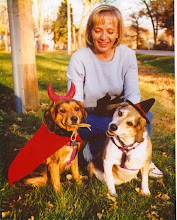Dogs with CDS may show behavioral changes such as confusion and forgetfulness, and may be less responsive to their owners. Advances in veterinary medicine have made it possible for our companion animals to be with us longer, which is a wonderful thing. However, these advances have increased the population of geriatric pets, resulting in more dogs with CDS, and requiring us pet parents to become more knowledgeable about the syndrome.
The classic signs of CDS in old dogs include:
• Reduced activity
• Changes in sleeping patterns
• Reduced responsiveness to people• Lack of interest in surroundings
• Confusion, disorientation
• Pacing, wandering
• Inability to recognize familiar people
• Increased thirst
• Excessive panting
• Difficulty eating or reduced interest in food
• Loss of bladder and bowel control
• Difficulty navigating their environment
Valentine exhibited a number of these CDS symptoms. She would sometimes pace the floor and wander around, appearing to be confused. I once caught her staring into the glass door of our entertainment center and was sure that she thought it was the doggie door. I think Valentine’s problems were exacerbated by the fact that she had lost much of her vision. Fortunately, the loss of appetite and bladder control didn’t appear until the end of her time with us.
The most unusual behavior change that we noticed was her attitude toward her big sister, Tootsie Roll. From the day we brought Valentine into our home, she had always deferred to Tootsie’s top dog role. As she got older and CDS began to set in, she started picking fights with Tootsie. Everyone would be calmly sitting in the family room, and Valentine would begin to stare at Tootsie. Then she’d start to growl. Then, when we would try to defuse the situation, Valentine would go after her. It was so puzzling because we could never identify anything in particular that would put her into that frame of mind. It would just come out of the blue. I don’t know if she felt that it was time to challenge the aging alpha dog, or if she was feeling threatened in her beta situation, or what her befuddled little doggie brain was telling her.
There are a few things that may help dogs with CDS. Studies have shown an improvement in most dogs within one month of starting to receive L-Deprenyl (Anipryl). CDS is often associated with the depletion of dopamine, and this drug works by helping to prolong dopamine activity and by reducing the amounts of free radicals in the brain. Dietary changes may also help to alleviate CDS. Therapeutic diets containing antioxidants and omega-3 fatty acids are recommended.
Environmental stimulation in conjunction with dietary change, is good for old dogs. You CAN teach an old dog new tricks, and you should, to keep your dog’s mind working. We’ve all experienced or heard stories about older dogs becoming more lively with the introduction of a puppy into the household. Use caution with that because a very old dog might not adjust well to such a dramatic change.
Finally, the best things we can give our old dogs are love and understanding. Learning about CDS will help us to understand why our old dog has changed. And, love will help everyone to get through a difficult period in our friend’s life.










